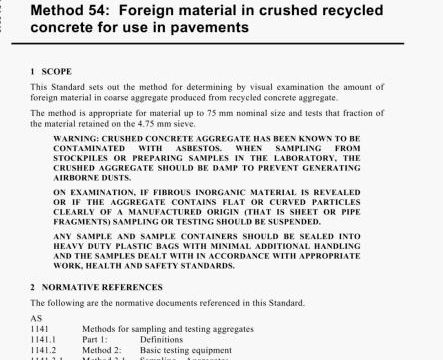AS 1141.54-2018 pdf download.Methods for sampling and testing aggregates Method 54: Foreign material in crushed recycled concrete for use in pavements.
This AS 1141.54 sets out the method for determining by visual examination the amount of foreign material in coarse aggregate produced from recycled concrete aggregate.
The method is appropriate for material up lo 75 mm nominal size and tests that fraction of the material retained on the 4.15 mm sieve.
S ARNING: CRU SHED CONCRETE AGGREGATE HAS BEEN KNOWN TO BE
CONTAMINATED WITH ASBESTOS. WHEN SAMPLING FRONt
STOCKPILES OR PREPARING SAMPLES IN THE LABORATORY, THE
CR1. SHED AGGREGATE SHOULD BE DAMP TO PREVENT GENERATING
AIRBORNE I)USTS.
ON EXAMINATION. IF FIBROUS INORGANIC MATERIAL IS REVEALED
OR IF THE AGGREGATE CONTAINS FLAT OR CURVED PARTICLES
CLEARLY OF A MANUFACTURED ORIGIN (THAT IS ShEET OR PIPE
FRAGMENTS) SAMPlING OR TESTING SHOLrI.D BE SUSPENDED.
AN SAMPLE AM) SAMPLE CONTAINERS SIIOULI) BE SEAIEl) INTO
HEAVY DEiTY PLASTIC BAGS WITH MINIMAL ADDITIONAL HANDLING
AND THE SAMPLES DEALT WITH IN ACCORDANCE WITh APPROPRIATE
%ORK, HEALTH ANt) SAFFTY STANDARI)S.
2 NORMATIVE REFERENCES
The following are the normative documenis referenced in this Standard.
1141 Methods for sampling and testing aggregates
1141.1 Part I: Definitions
1141.2 Method 2: Basic tesling equipment
1141.3.1 Method 3.1 Sampling—Aggregates
1141.11.1 Method I 1.1: Particle size distribution—Sieving method
3 I)IFINITIONS
For the purpose of this Standard, the definitions in AS 1141.1 and the one below apply.
3.1 Foreign material
Any crushed material other than crushed concrete or any contaminant introduced during the demolition and crushing process.
4 TYPES OF FOREIGN NIATERIAL.
Foreign material is categorized as follows:
(a) Type I or high density material such as asphalt, breccia. brick, ceramics glass. metal, sandstone, shale or slag (not blast furnace slag).
(b) Type II or lowdensity material such as plaster. plastic, rubber, clay lumps and other friable material.
(c) Type Ill or organic niatter such as wood, vegetable matter, paper, cloth, paint and bitumen.
5 APPARATUS
The following apparatus conforming to the provisions of AS 1141.2, is required.
(a) Balances—of suflicient capacity with a limit of performance not exceeding ±5 g for mass determinations >1 kg and ±0.5 g for mass determinations ≤1 kg.
(b) Drying oven—capable of operating at 105°C to 110°C.
(c) Sample dividers or quarlering equipn,enl.
(d) Sieve—a 4.75 mm sieve.
(e) Dishes. Ira vs and brushes.
6 PREPARATION
A test portion shall be prepared as follows:
(a) Obtain a sample of material using the appropriate procedure detailed in AS 1141.3.1.
(b) Obtain, either by quartering or by the use of a sample divider, a subsample containing at least 2 kg and not more than 5 kg retained on a 475 mm sieve.
(c) Handle in a manner that will avoid breaking up any clay lumps that may be present.
(d) Record the wet mass of the subsample (Me).
(C) Remove all clay lumps and friable material from the subsample and record their mass (mJ.
(f Dry the sub-sample to constant mass in the drying oven.
(g) Record the dry mass (M) of the sub-sample.
NOTE: If this test is performed in association with a particle size analysis. it is permissible to conduct a washed procedure in accordance to AS 1141.11.1 at this point and retain all sieve fraction retained on the 4.75 mm sieve as the test portion.AS 1141.54-2018 pdf download.Methods for sampling and testing aggregates
Methods for sampling and testing aggregates
